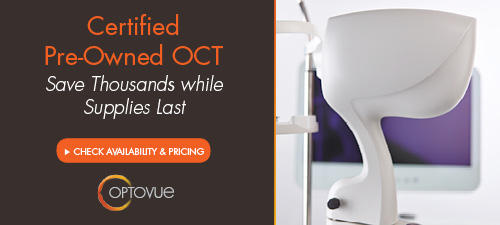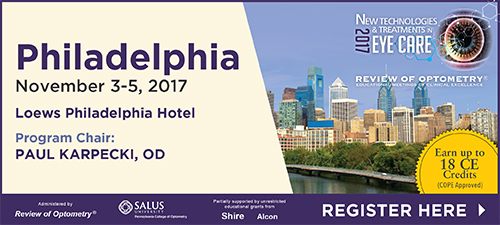
A
weekly e-journal by Art Epstein, OD, FAAO
Off the Cuff: Products, Services, Procedures: The Evolution of Optometry
While it may be comforting to assume that things will never change, optometry is itself a study in change. A century ago, optometrists sold spectacles from the back of jewelry stores and horse-drawn wagons. Today we have become the primary eye care profession.
|
|||||
 |
||
| Corneo-scleral Contact Lenses in An Uncommon Case of Keratoconus with High Hyperopia and Astigmatism | ||||
In a recent case report, a 45-year-old man seeking an eye examination due to the unsatisfactory quality of his vision wearing soft toric contact lenses presented with high hyperopia and astigmatism with bilateral keratoconus. He was fitted with corneo-scleral contact lenses (CScLs) to correct his irregular astigmatism and ocular aberrations. A diagnostic trial set was used in the fitting process, and the patient was assessed according to standardized fitting methodology. Visual acuity, corneal topography, biometry and ocular aberrations were evaluated. The follow-up period was one year.
The best spectacle-corrected visual acuity was 20/32 with +8.00 to 4.50×30° for the right eye (RE) and 20/25 with +7.75-2.25×120° for the left eye (LE). After the CScL fitting, visual acuity improved to 20/20 and 20/16 for the RE and LE, respectively. The patient wore these contact lenses an average of 13 hours a day. Total high order aberrations decreased by approximately 79% in the RE (2.37μm to 0.50μm) and 47% in the LE (1.04 μm to 0.55μm) after the CScL fitting. Visual quality and wearing time were maintained after one year of wearing CScLs. In addition, no adverse ocular effects were found during this period. The patient was successfully fitted with CScLs for management of keratoconus with high hyperopia and astigmatism. The lenses provided optimal visual quality along with prolonged use times and no adverse effects to the cornea. |
||||
SOURCE: Porcar E, Montalt JC, España-Gregori E, et al. Corneo-scleral contact lenses in an uncommon case of keratoconus with high hyperopia and astigmatism. Cont Lens Anterior Eye. 2017; Jul 13. [Epub ahead of print]. |
||||

|
||
| Microbial Characteristics of Posttraumatic Infective Keratitis | ||||
Consecutive patients with posttraumatic infective keratitis presenting to the ophthalmology department of a tertiary referral hospital in Singapore between March 2012 and March 2016 were prospectively identified to determine the demographics, risk factors, clinical and microbiological characteristics, and treatment outcome of posttraumatic infective keratitis. A standardized data collection form was used to document patient demographics, microbiological diagnosis, antibiotic sensitivity, and pretreatment and post-treatment ocular characteristics. Any contact lens-induced keratitis was excluded from the study.
In total, 26 patients were included for analysis. The mean age was 40 years (SD±19.4) and 84.6% of the patients were male. The majority of patients (69.2%, n=18) had sustained work-related injury in their eyes. Gram-negative organisms were predominant isolates (75.0%, n=12) in culture-positive corneal scrapings (n=16). Pan-sensitive Pseudomonas aeruginosa was the most common organism isolated among the culture-positive cases (56.2%, n=9). Three patients (18.7%) had developed fungal keratitis, and Acanthamoeba was isolated in one patient (6.2%) with polymicrobial keratitis. Infections resolved with medical treatment in 22 eyes (84.6%), and four eyes (15.3%) required therapeutic corneal transplantation. Researchers wrote that a shift of practice in tropical countries in posttraumatic infective keratitis cases should be considered to include Gram-negative cover. They added that front-line physicians such as ophthalmology and general practitioners should vigilantly reinforce work safety practices when initiating treatment and educating colleagues and new clinicians. |
||||
SOURCE: Lim BX, Koh VTC, Ray M. Microbial characteristics of posttraumatic infective keratitis. Eur J Ophthalmol. 2017; Jul 8. [Epub ahead of print]. |
||||
 |
||
| Comparison of Glaucoma Progression Between Unilateral and Bilateral Disc Hemorrhage Eyes, and Associated Risk Factors for Progression | ||||
A total of 78 bilateral primary open-angle glaucoma (POAG) patients who showed one or more occurrences of disc hemorrhage (DH) (48 eyes of 38 unilateral DH patients, and 30 eyes of 30 bilateral DH patients) were included to compare glaucoma progression between unilateral and bilateral (DH) eyes and determine associated risk factors. Glaucoma progression was defined by visual field (VF) deterioration. The mean VF global indices progression rates pre-DH and post-DH, and total follow-up periods were compared between the unilateral and bilateral DH groups.
Among the mean VF global indices progression rates, only the mean pattern standard deviation progression rate showed a statistically significant difference between the groups (unilateral DH group: 0.30±0.38 dB/y; bilateral DH group: 0.13±0.27 dB/y). Kaplan-Meier analysis revealed a greater cumulative probability of progression in the bilateral than in the unilateral DH group. The multivariate Cox's proportional hazard model indicated unilaterality of DH to be a factor associated with glaucoma progression. Investigators found that unilaterality of DH was associated with glaucoma progression in bilateral POAG patients with DH. Therefore, they suggested that clinicians needed to perform careful and frequent follow-up on bilateral POAG patients showing DH in only one eye during the follow-up period. |
||||
SOURCE: Seol BR, Kim YK, Jeoung JW, et al. Comparison of glaucoma progression between unilateral and bilateral disc hemorrhage eyes and associated risk factors for progression. J Glaucoma. 2017; Jul 17. [Epub ahead of print]. |
||||
|
|||
| News & Notes | |||||||||
| iDesign Advanced WaveScan Studio System to Treat Hyperopia With & Without Astigmatism The FDA’s Center for Devices and Radiological Health approved a new indication for the Star S4 IR Excimer Laser System and iDesign System. The system can now be used for LASIK patients with hyperopia, with and without astigmatism. In addition to myopia and mixed astigmatism, doctors can now treat hyperopia over a wide range of pupil sizes and those who are at least 18 years of age. Capturing five measurements in a single capture sequence—Wavefront aberrometry, Wavefront refraction, corneal topography, keratometry and pupillometry—the system can help save time during the procedure. This new indication for wavefront-guided LASIK is for use in patients: • With hyperopia with and without astigmatism as measured by the iDesign System up to +4.00D spherical equivalent, with up to 2.00D cylinder • With agreement between manifest refraction (adjusted for optical infinity) and the iDesign System refraction as follows: » Spherical equivalent: Magnitude of the difference is less than 0.625D » Cylinder: Magnitude of the difference is less than or equal to 0.5D • 18 years of age or older, and with refractive stability (a change of ≤1.0D in sphere or cylinder for a minimum of 12 months prior to surgery
|
|||||||||
Aerie Reports Positive Roclatan 0.02%/0.005% Phase III Topline Safety Results
|
|||||||||
| Academy’s Public Health and Environmental Vision Section Names Henry B. Peters Award Recipient The Public Health and Environmental Vision Section of the American Academy of Optometry announced that Melvin D. Shipp, OD, MPH, DrPH, is the recipient of the 2017 Henry B. Peters Award for Public Health and Environmental Vision. Dr. Shipp was chosen in recognition of his contributions to public health and optometry, his Diplomate status since 1990 and his service as section chair from 1996 to 1999. As a faculty member at the UAB School of Optometry, he taught public health to optometry students and was an integral part of the internationally recognized NEI-funded Collaborative Longitudinal Evaluation of Ethnicity and Refractive Error study, among other accomplishments. Dr. Shipp will be honored at the Public Health and Environmental Vision Section Awards Ceremony October 12 at the annual meeting in Chicago.
|
|||||||||
|
Optometric Physician™ (OP) newsletter is owned and published by Dr. Arthur Epstein. It is distributed by the Review Group, a Division of Jobson Medical Information LLC (JMI), 11 Campus Boulevard, Newtown Square, PA 19073. HOW TO ADVERTISE |





